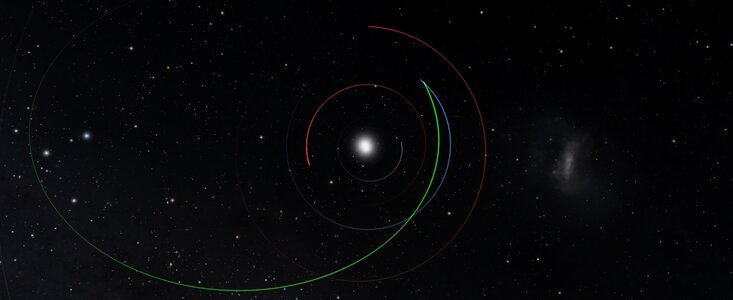Asteroid-Discovery Algorithm Created for Rubin Observatory Ensnares Its First ‘Potentially Hazardous’ Object
Milestone confirms that Rubin’s Legacy Survey of Space and Time is poised to uncover thousands of previously undiscovered near-Earth asteroids
2 August 2023
An asteroid discovery algorithm — designed to uncover near-Earth asteroids for Vera C. Rubin Observatory’s upcoming 10-year survey of the night sky — has identified its first potentially hazardous asteroid, a term for asteroids that currently pose no risk to Earth but may deserve further study.
Rubin Observatory is a Program of NSF’s NOIRLab and will conduct the unprecedented, decade-long survey of the sky called the Legacy Survey of Space and Time (LSST) when it begins operations in early 2025. Rubin is jointly funded by the National Science Foundation (NSF) and the US Department of Energy (DOE). NOIRLab, along with SLAC National Accelerator Laboratory, will operate Rubin.
The roughly 200-meter-long asteroid, designated 2022 SF289, was discovered during a test drive of the algorithm with the NASA-funded ATLAS survey by a team at the University of Hawaii’s Institute for Astronomy. Finding this object confirms that the next-generation algorithm, known as HelioLinc3D, will be better able to identify near-Earth asteroids than today’s methods.
The Solar System is home to tens of millions of rocky bodies. The closest of these — those with a trajectory that takes them within a few million kilometers of Earth’s orbit — warrant special attention. Such potentially hazardous asteroids, or PHAs, are systematically searched for and monitored to better calculate their trajectories.
From its exceptional vantage point on Cerro Pachón in Chile, Rubin Observatory will join the hunt for these objects and will dramatically increase the discovery rate of PHAs. Rubin will scan the sky with its 8.4-meter mirror and massive 3200-megapixel camera, visiting spots on the sky twice per night rather than the four times needed by present telescopes. But with this novel observing ‘cadence’, researchers need a new type of discovery algorithm to reliably spot space rocks.
With Rubin still under construction, the Rubin team at the University of Washington's DiRAC Institute wanted to test HelioLinc3D to see if it could discover a new asteroid in existing data, one with too few observations to be discovered by today’s conventional algorithms. They used HelioLinc3D to search through the ATLAS data and on 18 July 2023 it spotted its first PHA: 2022 SF289, initially imaged by ATLAS on 19 September 2022 at a distance of 21 million kilometers from Earth.
ATLAS had observed 2022 SF289 three times on four separate nights, but never the requisite four times on one night to be identified as a new NEO. But these are just the occasions where HelioLinc3D excels: it successfully combined fragments of data from all four nights and made the discovery.
Currently, scientists know of 2350 PHAs but expect there are many more to be found.
More information
NSF’s NOIRLab (National Optical-Infrared Astronomy Research Laboratory), the US center for ground-based optical-infrared astronomy, operates the International Gemini Observatory (a facility of NSF, NRC–Canada, ANID–Chile, MCTIC–Brazil, MINCyT–Argentina, and KASI–Republic of Korea), Kitt Peak National Observatory (KPNO), Cerro Tololo Inter-American Observatory (CTIO), the Community Science and Data Center (CSDC), and Vera C. Rubin Observatory (operated in cooperation with the Department of Energy’s SLAC National Accelerator Laboratory). It is managed by the Association of Universities for Research in Astronomy (AURA) under a cooperative agreement with NSF and is headquartered in Tucson, Arizona. The astronomical community is honored to have the opportunity to conduct astronomical research on Iolkam Du’ag (Kitt Peak) in Arizona, on Maunakea in Hawai‘i, and on Cerro Tololo and Cerro Pachón in Chile. We recognize and acknowledge the very significant cultural role and reverence that these sites have to the Tohono O’odham Nation, to the Native Hawaiian community, and to the local communities in Chile, respectively.
Rubin Observatory is a joint initiative of the National Science Foundation (NSF) and the Department of Energy (DOE). Its primary mission is to carry out the Legacy Survey of Space and Time, providing an unprecedented data set for scientific research supported by both agencies. Rubin is operated jointly by NSF’s NOIRLab and SLAC National Accelerator Laboratory (SLAC). NOIRLab is managed for NSF by the Association of Universities for Research in Astronomy (AURA) and SLAC is operated for DOE by Stanford University.
Links
- Photos Vera C. Rubin Observatory
- Videos Vera C. Rubin Observatory
- University of Washington Release
Contacts
James Urton
University of Washington
T: +1 206-543-2580
Email: jurton@uw.edu
Ranpal Gill
Vera C. Rubin Observatory
T: +1 520-309-6195
Email: rgill@lsst.org
Charles Blue
Public Information Officer
NSF’s NOIRLab
T: +1 202 236 6324
Email: charles.blue@noirlab.edu



